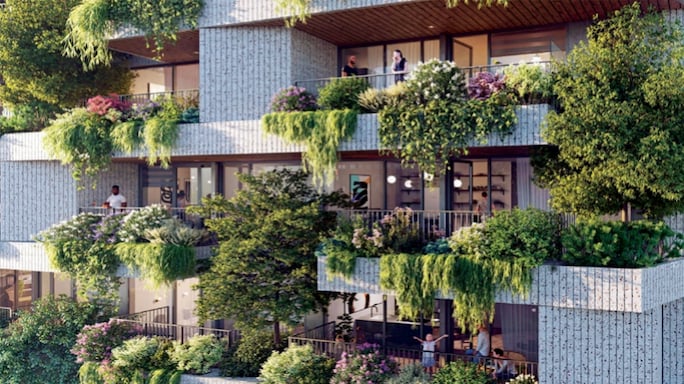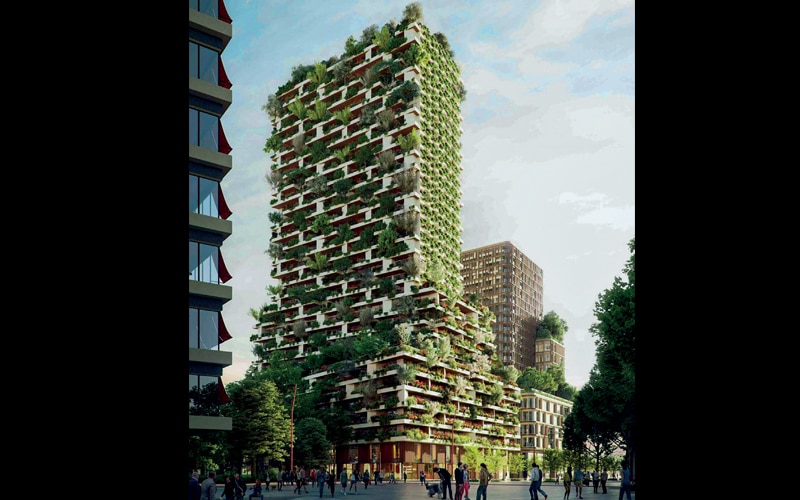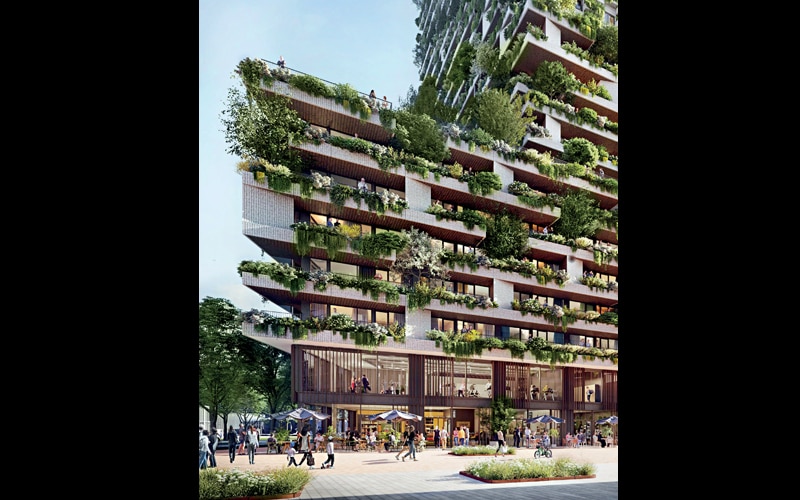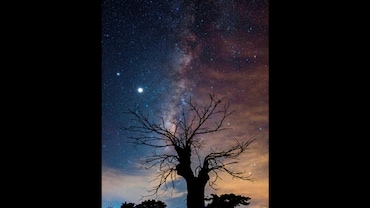- HOME
- /
- Features
- /
- Cover Story
- /
The Climate Changers: Is This the City of the Future?
Utrecht, Netherlands is taking green living to the next level
 Residents at the Wonderwoods Vertical Forest in Utrecht, Netherlands. Photo credit: Independent Photo Agency Srl/Alamy Stock Photo
Residents at the Wonderwoods Vertical Forest in Utrecht, Netherlands. Photo credit: Independent Photo Agency Srl/Alamy Stock Photo
Ducklings swim in convoy behind their mum along Catharijnesingel canal in Utrecht, Netherlands. It’s the only tailback you’ll see here these days, now that the motorway has gone. I watch them and imagine the media frenzy that would ensue in my native Britain if one of its cities turned a six-lane road into a canal for pleasure boating and nature viewing. Was there much uproar in Utrecht? “Not really,” Paul Manten, who led the project, tells me, as we stroll along the canal’s flower-strewn banks. “A few people who go everywhere by car didn’t like it.”
Many others saw it as righting a historic wrong. A canal was dug here 900 years ago as a defensive line for the city. It was controversially filled in with concrete in the 1960s, when the world went gung-ho for cars. Then in 2002, residents voted to bring the water back. Though Covid-19 scuppered the long-awaited grand reopening in 2020, the pandemic sparked a renaissance in active travel in other cities—a vindication for Utrecht, which, according to Manten, spent about one billion euros restoring Catharijnesingel and revitalizing the area around it.
“We were ahead of our time,” he says, as boats carrying passengers with glasses of wine in their hands pass by. “Everywhere is trying to do this now, make their cities greener.” No place, perhaps, is doing it with more grace than Utrecht. A short ride from Catharijnesingel, a verdant tower block is taking shape behind the train station. Wonderwoods Vertical Forest is an office and residential complex that will double as a 21/2-acre woodland. I look up at trees swaying on balconies and flowers draped over balustrades.
“I feel privileged to work on this,” says project manager Hedzer Pathuis, who met me onsite before the complex was completed in September last year. Wonderwoods heaves with 360 trees, 9,000 bushes and 10,000 plants. “There’s plenty of rain in Holland,” says Pathuis, as dark clouds threaten to prove his point. “In the basement there’s a basin that collects it. When it’s dry, we pump it up—hoses go to every plant.”
 Wonderwoods Vertical Forest has brought nature into urban high-rise design. Photo credit: Independent Photo Agency Srl/Alamy Stock Photo
Wonderwoods Vertical Forest has brought nature into urban high-rise design. Photo credit: Independent Photo Agency Srl/Alamy Stock Photo
That is a lot of upkeep. Who will do all the pruning? “A company has been contracted for 25 years to maintain the green,” says Pathuis. The service will cost residents around 60 euros a month—not an insignificant sum. And after 25 years? “The residents association will have to decide what to do.”
I picture living there, drinking coffee on a leafy balcony as day breaks over Utrecht. According to Pathuis, 60 of the 420 apartments will be affordable—“maximum rent about 1,000 euros a month for 20 years,” he says. In addition to flats, the building will have a cultural space for events and exhibitions, a winter garden, offices, restaurants, shops and a gym. So is this the green future of high-rise living? “It’s a pilot,” cautions Pathuis. Unknowns abound, chiefly: Do its eco-credentials add up?
Designed by Italy’s Stefano Boeri Architetti, Wonderwoods was commissioned in 2016, when the conversation about net-zero carbon dioxide (CO2) emissions was in its infancy. “The CO2 discussion was different then to what it is now,” says Pathuis. “The building needs a lot of concrete and steel because the plants are heavy, so from a CO2 point of view I don’t think it scores high. But the green is enhancing health, so it’s a trade-off.”
Wonderwoods is, if nothing else, an architectural statement—a challenge to other architects to design for nature, not just people. I get back on my bike and head for another site offering a less glamorous, but probably more realistic, vision of the future of architecture. I ride along the world’s oldest cycle path—a reminder that Utrecht has always been a green pioneer—and through the city’s new multistory bike park, the world’s largest.
When you ride around Utrecht, feeling the breeze on your face, catching snippets of chatter from passing cyclists, you realize that the Dutch are winning at the whole building-livable-cities thing. Utrecht is a city where “the future has already arrived,” says Rob Hopkins, an “imagination activist” and the founder of the Transition Network. He recorded the sound of the city’s cycle lanes in rush hour for Field Recordings from the Future, a music project designed to inspire a longing for a cleaner, greener, more human future.
 Independent Photo Agency Srl
Independent Photo Agency Srl
These soothing sounds accompany me to Hof van Cartesius, a ramshackle creative quarter. “It’s almost all built from waste material,” explains Iris Dijkstra, a local guide who shows me around. “It’s fun, isn’t it?” Nearby, kids play on a faded water slide salvaged from a theme park. Industrial crates heave with flowers.
“Hof van Cartesius is known for its commitment to sustainability and reuse of materials,” says Wilmer van den Berg, who runs the Warmoes resturant in the complex. “Our restaurant is a perfect example of this. It was built with materials salvaged from a former swimming pool.”
Record labels, sustainable fashion brands and architects are among the startups based at Hof van Cartesius. There’s a reclamation yard, too, where people can rent a workbench and tools for 10 euros an hour.
“People can use the workshop to adjust their buy,” says Sijmen Houben, showing me around. “It started in Rotterdam, now there’s one here and in Antwerp. It would be good if this caught on everywhere, no?” I have been having the same thought for most of the day.
Positive News (2024), ©️ 2024 by Positive News.






